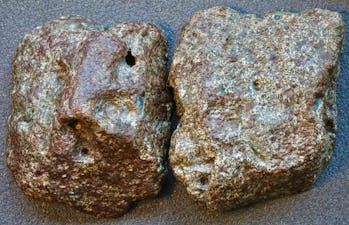Ancient Beyond Time Itself
 |
"I have been working on meteorites for more than 20 years now, and this is possibly the most fantastic new meteorite I have ever seen.""When you go close to the beginning of the solar system, it’s more and more complicated to get samples.""We probably will not find another sample older than this one.""When we saw the first descriptions of this rock, it was really obvious that this rock was unusual.""The age was not the sole point of interest. We were extremely interested by the genesis of such extraterrestrial andesitic melts and on the processes of formation of primordial crusts. Such samples are extremely precious.""It is not a meteorite freshly fallen on Earth. It is slightly weathered, but we know since the study of the Tatahouine meteorite that terrestrial weathering is fast even in the Sahara."Jean-Alix Barrat, University of Western Brittany, France
 |
| Pieces of the meteorite Erg Chech 002 were found to contain andesite, which was likely formed from an ancient protoplanet. Steve Jurvetson / Flickr |
"This meteorite is the oldest magmatic rock analyzed to date and sheds light on the formation of the primordial crusts that covered the oldest protoplanets.""[Previous studies have found that such silica-infused andesite crusts were likely common during our solar system’s protoplanet-forming stage], contrary to what the meteorite record suggests.""EC 002 is clearly distinguishable from all asteroid groups, and no object with spectral characteristics similar to EC 002 has been identified to date.""[Remnants of primordial crusts are] not only rare in the meteorite record, but they are also rare today in the asteroid belt."Researchers study published in Proceedings of the National Academy of Science
Wonders never cease and science, like nature, never sleeps. A 4.6-billion-year-old meteorite rock has been discovered in the Sahara Desert by researchers who say their find was in primordial times part of a protoplanet that failed to develop, its constituent parts simply vanished or were absorbed by other like protoplanets. It is fairly certain, however, that this meteorite may be the oldest such mineral that has ever been identified, analyzed and now reigns as one-of-a-kind. A Methusala of all minerals extant in the Universe.
A veritable marvel of a remnant of a once-existing cluster of chemicals, gases, metals and minerals aspiring to become a planet. The rock is a reminder of once was and what became; existing as one of the rare pieces of natural evidence that the solar system has its own planetary ancestors. The rock was named Erg Chech 002 and its discovery took place in May of 2020 in the Erg Chech area of southwestern Algeria where the rock was immediately identified by the scientists studying it as unusual.
Most meteorites are composed of basalt -- produced in the wake of a fiery explosion producing lava which cools to become the mineral we know as basalt. This meteorite, however has a much different composition; a rare volcanic rock named andesite. According to the research paper, the rock was classified as an chrondite -- igneous rock produced from molten magma emanating from a body's internal melting, distinguishing the core from its crust.
 |
| Big Think |
According to the Meteoritical Bulletin Database there are only 3,179 achrondites identified, 75 percent of which originated in the crust and mantle of the asteroid 4 Vesta in the asteroid belt within our solar system. They are limited in what can be revealed regarding the solar system's planetary history diversity, since they emanate from a limited source of only several planetary bodies.
And this is another thing that makes this andesitic achrondite so different from any others that have been discovered. It was once molten and had solidified some 4.6 billion years ago, as revealed by chemical analysis.
Such andesitic rock, it appears from the experience of the researchers, are rarely to be found in the asteroid belts within our solar system. Which led the researchers to conclude the rock must represent a remnant of a long-lost protoplanet once in the early formation stage and as such EC 002 may be the sole evidence that a primordial protoplanet ever existed, failing to mature and expiring.
Had any other relics existed they might have been smashed beyond existence or absorbed within the constituents of other protoplanets.
 |
The CEERS Survey researchers will use the James
Webb Space Telescope to observe the Extended Groth Strip in infrared
light. Their observations employ three of the telescope’s instruments
and will provide both images and spectra of the objects in the field —
which includes at least 50,000 galaxies — helping to expand what we know
about galaxies in the very early universe.
Credits: NASA, ESA, and M. Davis (University of California, Berkeley) |
Labels: Astronomy, Meteorites, Protoplanet Constituents, Research, Sahara Desert

0 Comments:
Post a Comment
<< Home